Book Reviews, Merchant Marine Books
by T. Horodysky, WebMistress
The Annals of the U.S. Merchant Marine Academy Class of 1942 History Project CD, Class of 1942 Book Committee, 1997
At All Costs: How a Crippled Ship and Two American Merchant Marines Turned the Tide of World War II
Build Ships! Wartime Shipbuilding Photographs, San Francisco Bay 1940-1945
Captain's A Woman: Tales of a Merchant Mariner
Captives of Shanghai: The Story of SS President Harrison
The Forgotten Heroes: The Heroic Story of the United States Merchant Marine
From Dry Dock to D-Day - The Return Voyage of the SS Jeremiah O'Brien
Hannibal Victory: The Voyage of a Victory Ship in WWII [Video]
Last of the Boom Ships, Oral Histories of the U.S. Merchant Marine 1927-2000
The Liberty Ships from A (A.B. Hammond) to Z (Zona Gale)
Liberty Ships: The People Behind the Names
Marinship at War, Shipbuilding and Social Change in Wartime Sausalito
Patriots and Heroes:True Stories of the U.S. Merchant Marine in World War II
Patriots and Heroes:True Stories of the U.S. Merchant Marine in World War II. Volume 2
Pirates & Patriots of the Revolution: An Illustrated Encyclopedia of Colonial Seamanship
Ship of Miracles: 14,000 Lives and One Miraculous Voyage
Torpedo Junction: U-Boat War off America's East Coast, 1942
U.S. Merchant Marine at War, 1775-1945
The United States Merchant Marine At War, Report of the War Shipping Administrator to the President
Until the Sea Shall Free Them: Life, Death And Survival In The Merchant Marine
NEW! The Victory Ships From A (Aberdeen Victory) to Z (Zanesville Victory)
Woody, Cisco, & Me -- Seamen Three in the Merchant Marine
A Voyage to Abadan, Bill Jopes with Doug Dekeyser, Xlibris Corporation, 1999
Jopes is a natural-born storyteller -- I couldn't put this book down. In 1943, at age 20, Bill Jopes became a Merchant Marine Cadet, and after a short period of "basic training," went to sea, since that was part of the curriculum.
Deck Cadet Jopes and Engine Cadet Doug Dekeyser joined the T-2 tanker SS Yamhill for her maiden voyage in Portland, Oregon in November 1943 and stayed aboard until August 1944 in Baltimore. In between they shuttled between Abadan in the Persian Gulf, India and Australia, carrying aviation gas wherever it was needed.
To add to their own memories, Dekeyser and Jopes got the Yamhill's logs from the National Archives to help reconstruct the story. These young Cadets saw exotic ports in war-time, did a surprise refueling of an aircraft carrier, and most fascinating of all, fought an all day duel with a Japanese submarine.
It's obvious Jopes is not a professional writer -- there's too many misplaced commas and wrong statistics -- but he's written a great book.
The book is available from Xlibris.com at $25.00 for hardback, $14.40 paperback or Amazon.com, Barnes and Noble.com for $25.00 and $18.00
Action in the South Atlantic, by Michael Higgins; published by The Propeller Club, Port of Brunswick; P.O. Box 611; Brunswick, GA 31521 on sale for $6.50 plus $3.50 S & H, to raise funds for the two Merchant Marine monuments in Brunswick.
This is a very well done book, which covers the sinking of the SS Esso Baton Rouge and SS Oklahoma off the Georgia coast in April of 1942. The author is well versed in maritime history, being a graduate of The State University of New York - Maritime College and founder of the Confederate Navy Historical Society. He provides good background material about the status of the Battle of the Atlantic to help the reader to put the sinkings in perspective.
The book includes quotes from local residents who welcomed the survivors of these two ships torpedoed within moments of each other, and comments from the Captain of the U-boat. There are many illustrations to add to our understanding of the story, which culminates in the identification of 5 unknown (badly burned) seamen in late 1998. It's a worthwhile book, and a good cause.
Action In The South Atlantic; the Sinking of the German Raider Stier by the Liberty Ship Stephen Hopkins, by Gerald Reminick. Palo Alto, CA: Glencannon Press Maritime Books, 2006
We own a copy of the only previously published book about the story of the SS Stephen Hopkins: Witt, and Heaton's: "The Gallant Ship, Stephen Hopkins." It comprises 52 pages. Reminick's new book about the Stephen Hopkins is 304 pages! Reminick found new information and amazing photographs in the National Archives, from family members, and in Germany. He interviewed the three living survivors and found previously unknown accounts of the battle and the 31-day lifeboat voyage. The book is well researched and well written. This is a fascinating, must-read for all lovers of history. Reminick is Professor of Library Services at Suffolk County Community College, Brentwood, NY.
Read www.usmm.org feature: The Gallant Liberty Ship SS Stephen Hopkins Sinks a German Raider
The Annals of the U.S. Merchant Marine Academy Class of 1942 History Project CD, Class of 1942 Book Committee, 1997
For its 50th Anniversary the Merchant Marine Academy Class of 1942 surveyed its members about their experience in World War II and put the information together in a limited edition book. Several years later they turned the book into a CD. The CD includes an extensive, illustrated history of the Academy and the Cadet Corps Schools. A "War at Sea" section comprises 39 pages.
The Committee reached about one third of the Class and the results of their surveys vary: some men only filled out a brief form, but most wrote of their wartime experience in the Merchant Marine or Navy. There are 900 pages of recollections, many of them fascinating. Unfortunately, you have to scroll through the boring ones too.
Presented as a CD, this "book" has its pluses and minuses. It's cheap to produce, so it is reasonably priced -- a book this size in a small printing would cost at least $75. But reading a lot of text on-screen is not easy -- after a few pages I decided to print out the "War at Sea" section. These are Acrobat files, the pages are clear on screen and in print.
The CD is available for $25.00 ($15.00 tax deductible), check payable to:
U.S. Merchant Marine Academy Foundation for "U.S. MMA Class '42 History Project"
Attn. Mr. Virgil R. Allen '73, President
USMMA Foundation
P.O. Box 19362
Newark, NJ 07195
At All Costs: How a Crippled Ship and Two American Merchant Marines Turned the Tide of World War II, by Sam Moses. New York: Random House, 2006
I thought I knew the story of "Operation Pedestal," the last-ditch convoy to Malta. I read three books on the subject by British authors before I put together Operation Pedestal and SS Ohio save Malta. But when Sam Moses sent me the manuscript for “At all Costs” to check for technical errors, I could not put it down. I stayed up half the night, astounded by the information he gathered, and impressed with how he wove the story together into an Indiana Jones-type narrative.
At all Costs has the perfect mix of romance, adventure, and handsome American heroes, in a brilliantly-told story of a critical battle of World War II. The success of "Operation Pedestal," which ran a 1,000 mile gauntlet of German and Italian bombers, submarines, and torpedo boats to resupply Malta, made possible Allied victory in North Africa and beyond. In At all Costs the focus is on two Americans, Fred Larsen and Francis "Lonnie" Dales, whose actions earned them the Merchant Marine Distinguished Service Medal "For heroism above and beyond the call of duty."
Bravo, Sam Moses!
Moses is an adventurer, former writer for MotorCycle Weekly, Sports Illustrated, and AutoWeek. Currently he writes for the Portland Tribune. He authored Fast Guys, Rich Guys and Idiots, about auto racing.
Build Ships! Wartime Shipbuilding Photographs, San Francisco Bay 1940-1945, Wayne Bonnett, Windgate Press, PO Box 1715, Sausalito, CA 94966, 1999.
Build Ships! is an extraordinary book. It tells a terrific story through its selection of outstanding and never-before-seen photographs, which will appeal to any lover of ships, the sea, or anyone with an appreciation for American craftsmanship and ingenuity.
This is a "coffee-table" book, and paper and printing are extremely high quality, so these photographs -- I'd guess close to 150 photos -- show beautifully.
While the subtitle refers to San Francisco shipbuilding, only a half dozen before-and-after photos showing aerial views of shipyards might be uninteresting to those who live outside the Bay Area, since shipyard techniques were similar throughout the U.S. in that era. The 30 shipyards, which employed 200,000 workers built everything from PT boats, submarines, cruisers, T-2's and Libertys. Covered in this book are the famous Kaiser Richmond yards, MarinShip, Hunters Point, Mare Island, Moore Drydock and many more.
Extremely fascinating were the side-by-side photo comparisons of World War I and World War II shipbuilding methods; photos comparing ships at launching and after fitting out, and preparing for launching. The creators of this book showed a good design in creating diagrams to compare steps in launching, exploded views of a Liberty, or types of cranes used in a shipyard.
For 1990's women used to the idea that a woman can do any job, the photo essay discussing recruiting and training "Wendy the Welder" will be a great revelation.
Don't miss it! $45 plus $4 S&H from publisher or through Amazon.com
Captain's A Woman: Tales of a Merchant Mariner, Deborah Doane Dempsey and Joanne Foster, Annapolis: Naval Institute Press, 1998I really looked forward to reading this book, the biography of the first American woman to earn her Third Mate, Second Mate, Chief Mate, and Master's licenses.
Deborah Doane Dempsey was the first woman enrolled at Maine Maritime Academy and graduated as valedictorian in 1976. She sat for her Master's license in 1984, scoring extremely high on this four and a half day exam.
She first sailed on her Master's license in 1989 for Lykes and was given awards for saving a "runaway" ship which broke its tow in a storm and for her service during the Persian Gulf War.
I was somewhat disappointed, feeling that it was a great magazine article stretched into a book. The co-authors, Deborah Doane Dempsey and Joanne Foster, the Captain and a landlubber -- passenger aboard the Charlotte Lykes -- wrote alternating chapters.
Some of the writing is poor -- I found myself rereading sentences to figure out what the author was trying to say. Technical terms are not explained as they should be.
Interesting chapters dealt with Deborah Doane Dempsey's determination in the face of discrimination during her years at the Academy and at sea, and her heroic efforts at averting an environmental disaster by keeping a drifting ship from crashing onto a rocky coast. Unfortunately, that is overshadowed by minutia such as the color of wallpaper in her office and the entire diary of a voyage delivering a yacht. Unfortunately, she gives short shrift to her Gulf War voyages.
Joanne Foster's chapters give us a outsiders view of shipboard life, but again, having space to fill, she focuses on her shopping expeditions and restaurant menus in port, and the winner at cribbage each night during her 40 days on board.
Captives of Shanghai: The Story of SS President Harrison, David H. Grover and Gretchen G. Grover, Napa, CA: Western Maritime Press, 1999prior to reading this book, I had read a few short descriptions of the SS President Harrison's saga. Much had puzzled me -- starting with the timing of her second voyage to rescue U.S. Marines from China.
This father-daughter teams meticulously researched the situation in those tense last weeks of November and early December 1941 in the Far East -- including the movements and capabilities of U.S. Navy and U.S. merchant ships. They examine the available choices and decisions that influenced the course of events.
The authors recount the various tales of captivity for the Harrison's officers and crew -- the Japanese treated the officers as military and the crew as civilian captives -- as well as the fate of the U.S. Marines. The Harrison's Master was charged with damaging Japanese property, i.e., deliberately ripping out the bottom of the ship to keep her out of Japanese hands.
The Grovers follow the fate of the Harrison, her salvage and sinking by a U.S. submarine while loaded with POW's and bring up the mystery of the "Peking Man," whose fossils were to be carried on the Harrison.
This well-written, interesting book is available in many nautical bookstores.
Convoy PQ18: Arctic Victory, Peter C. Smith, London: New English Library, 1975Peter Smith gives a thorough account of PQ 18, the next after disastrous PQ 17. He discusses the strategies used by escorts which took into account the lessons learned at such great cost two months earlier in July 1942.
PQ 18 comprised 40 merchant ships flying the flags of 4 countries: 11 British, 20 American, 6 Soviet Union, 3 Panamanian. The British provided all the escorts: a light cruiser, an American-built escort carrier with a maximum capacity of 15 underpowered planes, countless destroyers, two anti-aircraft ships, two submarines with their own escorts, and two fleet oilers with escorts. PQ 18 marked the first use of an escort carrier, also known as "baby flattop" to protect a convoy. [Unfortunately they were not used on the trans-Atlantic route until May 1943.]
Smith's diagrams and maps makes it easy to follow the battle during the harrowing passage between Arctic pack ice on the North, Norway-based Stukas and Junkers 88 bombers, and the silent menace of Nazi U-Boats. Smith explains the fate of the convoy once it reaches Archangel, and also covers the course of eastbound convoy QP 14, which started its journey nearly simultaneously.
Smith notes the Allies considered PQ 18 a "success." The reader should make their own decision about this "success" after reading the book. The book has been reprinted a few times and used copies are often available online. A good companion to David Irving's Destruction of PQ-17.
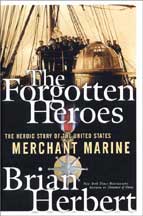 One
of our regular correspondents first brought this book to our attention,
noting that this web site was frequently cited as a reference. I looked
forward to reading this book since its author was a "multiple New York
Times bestseller," albeit, known for his science fiction novels.
One
of our regular correspondents first brought this book to our attention,
noting that this web site was frequently cited as a reference. I looked
forward to reading this book since its author was a "multiple New York
Times bestseller," albeit, known for his science fiction novels.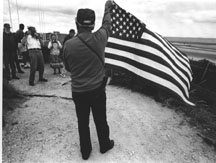 From Dry
Dock to D-Day - The Return Voyage of the SS Jeremiah O'Brien,
From Dry
Dock to D-Day - The Return Voyage of the SS Jeremiah O'Brien,
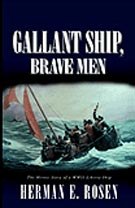 Gallant
Ship - Brave Men is billed as "the heroic story of survival
and death for thirty days in an open lifeboat without food or water."
Author Herman Rosen was one of four Cadet-Midshipmen aboard the Liberty
ship SS John Drayton when she was torpedoed by an Italian
submarine. Cadet Rosen kept a diary which survived the ordeal, and the book
is based on his notes and recollections. It's a good story which should
be read by anyone interested in the story of the Merchant Marine during
World War II.
Gallant
Ship - Brave Men is billed as "the heroic story of survival
and death for thirty days in an open lifeboat without food or water."
Author Herman Rosen was one of four Cadet-Midshipmen aboard the Liberty
ship SS John Drayton when she was torpedoed by an Italian
submarine. Cadet Rosen kept a diary which survived the ordeal, and the book
is based on his notes and recollections. It's a good story which should
be read by anyone interested in the story of the Merchant Marine during
World War II. 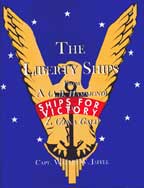 The
Liberty Ships from A to Z is an outstanding book, a true encyclopedia
of the Liberty ship, its design, construction, statistics, and problems.
Did you realize more Libertys lost their propellers than developed cracks?
Following the introductory chapters, the book lists every Liberty ship,
grouped into categories such as World War II losses, ships scrapped from
the "mothball fleet," military operated, artificial fish reefs,
etc.
The
Liberty Ships from A to Z is an outstanding book, a true encyclopedia
of the Liberty ship, its design, construction, statistics, and problems.
Did you realize more Libertys lost their propellers than developed cracks?
Following the introductory chapters, the book lists every Liberty ship,
grouped into categories such as World War II losses, ships scrapped from
the "mothball fleet," military operated, artificial fish reefs,
etc. 
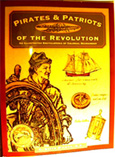 Pirates
& Patriots of the Revolution: An Illustrated Encyclopedia of Colonial
Seamanship, C. Keith Wilbur, Old Saybrook, Connecticut: The Globe Pequot
Press, 1973, 1984
Pirates
& Patriots of the Revolution: An Illustrated Encyclopedia of Colonial
Seamanship, C. Keith Wilbur, Old Saybrook, Connecticut: The Globe Pequot
Press, 1973, 1984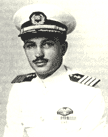 SSS, Captain J. W. Clark,
Kings Point, New York: American Merchant Marine Museum, 2000. Available
from
SSS, Captain J. W. Clark,
Kings Point, New York: American Merchant Marine Museum, 2000. Available
from 
 NEW!
The Victory
Ships From A (Aberdeen Victory) to Z (Zanesville Victory), by Walter
W. Jaffee, Palo Alto, California:
NEW!
The Victory
Ships From A (Aberdeen Victory) to Z (Zanesville Victory), by Walter
W. Jaffee, Palo Alto, California: